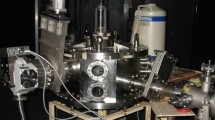Abstract
At present, Thailand uses medicinal plants to treat various diseases. Alternative medicine utilizes Gymnema inodorum Lour for antipyretic and anti-allergic purposes. There are also other research studies to treat diabetes mellitus, coronary artery disease, cataract, rheumatoid arthritis, gout, liver cancer, and stomach cancer. This study used particle-induced X-ray emission (PIXE) technique to analyze the elements in this plant. The advantage of this technique over other methods is the multi-elemental analysis and high sensitivity. The objective of this study was to determine the elemental compositions and to develop new standard methods for analyzing plant elemental compositions in Thailand. A 2-MeV proton beam was used to identify and characterize major and minor elements namely Mg, Al, Si, P, S, Cl, K, Ca, Ti, Mn, Fe, and Zn in Gymnema Inodorum Lour. Results have shown that these elements are present in varying concentrations in the selected parts: roots, stems, and leaves. The data of elemental analysis, applied in recommended quantities that are harmful to the body, describe the relationship between elements and efficacy of this plant in alternative medicine.







Similar content being viewed by others
References
Bespinyowong R. Gymnema Inodorum Lour. [Internet]. 2013 [cited2016 June 20]. Available from: http://www.chulapedia. chula.ac.th/index. php/phak chiang da
Thai Crude Drug by Faculty of Pharmaceutical Sciences, (2010) Ubon Ratchathani University. Acorus calamus Linn. [Internet]. [cited 2016 June 30]. Available from: http://www.Thaicrudedrug.com/main.php?action=viewpage&pid=124
Saengpet P. (2015) How to make Gymnema Inodorum tea. Matichon public Co.[Internet]. [cited 2016 June 20]. Available from: http://technologychaoban.com/news_detail. php?tnid
Bureau of Alternative Medicine. (2016) Alternative Medicine Situation in Thailand. [Internet] [cited 2016 June 20]. Available from: http://thaicam.go.th
Charoeansin S. (2014) Human biochemical nutrition. Phayao: School of Medical Sciences, University of Phayao
Green Clinic. (2016) Mineral [Internet]. [cited 2016 December 28]. Available from: http://www.greenclinic.in.th/minerals. html
Leelahakul V, Putadechakum S, Thaweeboon T (2002) Nutritional nursing, edition 2 edn. boonsiri print, Bangkok
Wirunthanakhwan N. (2016) Mineral [Internet]. [cited 2016 December 25]. Available from: https://healthgossip.co/what-is-mineral/
Govil M (2001) Proton induced X-ray emission-a tool for non-destructive trace element analysis. Curr Sci 80(12):1542–1549
Prithiviraj B, Manikandan E, Hariharan GN, Nair KGM (2011) elemental accumulation patterns of the lichen species Physcia Tribacoides Nyl., Heterodermia Dissecta and Bacidia Beckhausii Körber from the Walayar Rf region, Tamil Nadu, India. Int J PIXE 21(03&04):133–144
Manikandan E, Bharath Prithiviraj G, Kavitha P (2011) Magudapathy and B. Rajamannan, 2 MeV-PIXE technique for coastal material analysis. Int J PIXE 21(03&04):75–86
Gowrishankar R, Kumar M, Menon V, Divi SM, Saravanan M, Magudapathy P, Panigrahi BK, Nair KG, Venkataramaniah K (2010) Trace element studies on Tinospora cordifolia (Menispermaceae), Ocimum sanctum (Lamiaceae), Moringa oleifera (Moringaceae), and Phyllanthus niruri (Euphorbiaceae) using PIXE. Biol Trace Elem Res 133:357–363
Ravisankar R, Rajalakshmi A, Eswaran P, Meenakashisundram V, Gajendiran V, Manikandan E, Magudapathy P, Panigrahi BK, Nair KGM (2007) Gamma-ray spectroscopic and PIXE analysis of beach rock samples of South East Coast of Tamilnadu. India Int J PIXE 17(03&04):193–203
Won-in K, Suksawang S, Thongleurm C, Intarasiri S, Tippawan U, Kamwanna T, Dararutana P (2012) PIXE study on Thai Amulet: Phra Somdej Wat Rakhang. J Radioanal Nucl Chem 294:384–386
Won-in K, Sako T, Thongleurm C, Intarasiri S, Tippawan U, Kamwanna T, Pattanasiriwisana W, Tancharakorn S, Kamonsutthipaijit N, Dararutana P (2013) Nuclear analytical methods on ancient Thai rice. J Radioanal Nucl Chem 297:285–290
Ministry of public health. (1998) Thai recommended daily intakes-Thai RDI. [internet]. [cited 2016 July 5]. Available from: food.fda.moph.go.th/Rules/datRules/4-4-2ThaiRDI.pdf
Huncharek M, Muscat J, Kupelnick B (2009) Colorectal Cancer risk and dietary intake of calcium, vitamin D, and dairy products: a meta-analysis of 26,335 cases from 60 observational studies. Nutr Cancer 61(1):47–69
Weingarten MA, Trestioreanu AZ, Yaphe J (2008) Dietary calcium supplementation for preventing colorectal cancer and adenomatous polyps. Cochrane Database Syst Rev 1:1–19
Zemal MB, Miller SL (2004) Dietary calcium and dairy modulation of adiposity and obesity risk. Nutr Rev 62(4):125–131
Zemel MB, Shi H, Greer B et al (2000) Regulation of adiposity by dietary calcium. FASEB J 14:1132–1138
Wang L, Manson JE, Buring JE et al (2008) Dietary intake of dairy products, calcium, and vitamin D and the risk of hypertension in middle-aged and older women. J Am Heart Assoc 51:1–7
The Food and Nutrition Board of the Institute of Medicine, (2011) National Academy of Sciences. Nutrient Recommendations: Dietary Reference Intake (DRI). [Internet]. [cited 2016 July 1]. Available from: http://ods.od.nih.gov/Health_Information /Dietary_Reference_Intakes.aspx
Lee H, Lee J, Hwang SS, Kim S et al (2013) Potassium intake and the prevalence of metabolic syndrome: the Korean National Health and nutrition examination survey 2008–2010. PLoS One 8(1):1–9
Acknowledgements
This study was financially supported by the Faculty of Medicine, Chiang Mai University, Chiang Mai, Thailand. We extend special thanks to the Department of Forensic Medicine for supporting this study. Thank you to the Plasma and Beam Physics Research Facility, Faculty of Sciences, Chiang Mai University, for carrying out this research work.
Author information
Authors and Affiliations
Corresponding author
Ethics declarations
Conflict of Interest
The authors declare that they have no conflict of interest.
Additional information
Publisher’s Note
Springer Nature remains neutral with regard to jurisdictional claims in published maps and institutional affiliations.
Rights and permissions
About this article
Cite this article
Sukum, P., Narongchai, P., Boonyawan, D. et al. Determination of Elements in Gymnema inodorum Lour by Particle Induced X-Ray Emission (PIXE). Biol Trace Elem Res 192, 330–335 (2019). https://doi.org/10.1007/s12011-019-01669-8
Received:
Accepted:
Published:
Issue Date:
DOI: https://doi.org/10.1007/s12011-019-01669-8




